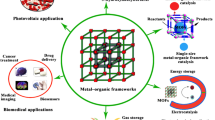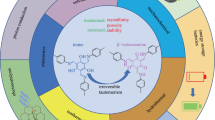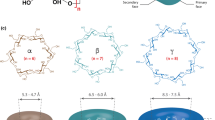Abstract
A columnar modification of β-cyclodextrin (β-CDcol) has been synthesized using self-assembly and self-organization processes. It is shown that the obtained macrocycle assemblies in the solid state are highly ordered structures with through cylindrical pores with an average diameter of ∼0.7 nm and a length of about 60 nm. These structures can be of interest as a new type of macroreceptors for the inclusion of molecules with diameters not exceeding 0.7 nm belonging to various chemical classes. The abilities of the common cage structure of β-CD and the β-CDcol modification to bind low-molecular-weight volatile organic compounds have been compared. The dependence of the composition, structure, and thermal stability of the inclusion complexes on the ligand nature and geometry is analyzed. The absence of any specificity in the adsorption of ligands on β-CDcol and the possibility of using this structure as a stable nanocontainter for the storage of volatile compounds is demonstrated.
Similar content being viewed by others
References
S. Znagaki, Y. Fukushima, and K. Kuzoda, “Synthesis of Highly Ordered Mesoporous Materials from a Layered Polisilicate,” Chem. Soc., Chem. Commun., No. 8, 680 (1993).
I. K. Ying, C. P. Mehnert, and M. S. Wong, “Synthesis and Applications of Supramolecular-Templated Mesoporous Materials,” Angew. Chem., Int. Ed. 38, 56 (1999).
V. V. Gorbatchuk, A. G. Tsifarkin, I. S. Antipin, V. N. Solomonov, A. I. Konovalov, P. Lhotak, and I. Stibor, “Nonlinear Structure-Affinity Relationships for Vapor Guest Inclusion by Solid Calixarenes,” J. Phys. Chem. B 106, 5845 (2002).
V. V. Gorbachuk, L. S. Savel’eva, M. A. Ziganshin, I. S. Antipin, and V. A. Sidorov, “Molecular Recognition of Organic Guest Vapor by Solid Adamantylcalix[4]arene,” Izv. Akad. Nauk, Ser. Khim., No. 1, 60 (2004).
J. L. Atwood, L. J. Barbour, and A. Jerga, “Storage of Methane and by Interstitial van der Confinement,” Science (Washington) 296, 2367 (2002).
P. K. Thallapally, T. B. Wirsing, L. J. Barbour, and J. L. Atwood, “Crystal Engineering of Nonporous Organic Solids for Methane Sorption,” Chem. Commun. (Cambridge), No. 35, 4420 (2005).
A. Collet, “Cyclotriveratrylenes and Cryptophanes,” Tetrahedron 43, 5725 (1987).
S. Noro, S. Kitagawa, M. Kondo, and K. Seki, “A New, Methane Adsorbent, Porous Coordination Polymer [{CuSiF6(4,4′-bipyridine)2}n],” Angew. Chem., Int. Ed. 39, 2081–2084 (2000).
M. Eddaoudi, J. Kim, N. Rosi, D. Vodak, J. Wachter, M. O’Keeffe, and O. M. Yaghi, “Systematic Design of Pore and Functionality in Isoreticular MOFs and Their Application Methane Storage,” Science (Washington) 295, 469 (2002).
L. Dobrzanska, G. O. Lloyd, H. G. Raubenheimer, and L. J. Barbour, “A Discrete Metallocyclic Complex That Retains Its Solvent-Templated Channel Structure on Guest Renoval to Yield a Porous, Gas Sorbing Material,” J. Am. Chem. Soc. 127, 13 134 (2005).
T. W. Ebbesen, “Carbon Nanotubes,” Phys. Today 49, 26 (1996).
A. C. Dillon, K. M. Jones, T. A. Bekkedahl, C. H. Kiang, B. S. Bethune, and M. J. Heben, “Storage of Hydrogen in Single-Walled Carbon Nanotubes,” Nature (London) 386(6623), 377 (1997).
C. F. Liu, Y. Y. Fan, M. Liu, H. T. Cong, H. M. Cheng, and M. S. Dresselhaus, “Hydron Storage in Single-Walled Carbon Nanotubes at Room Temperature,” Science (Washington) 286, 1127 (1999).
S. V. Krivovichev, V. Kahlenberg, I. G. Tananaev, R. Kaindl, E. Mersdorf, and B. F. Myasoedov, “Highly Porous Uranyl Selenate Nanotubules,” J. Am. Chem. Soc. 127, 1072 (2005).
S. V. Krivovichev, V. Kahlenberg, I. G. Tananaev, R. Kaindl, E. Mersdorf, and B. F. Myasoedov, “Nanoscale Tubules in Uranyl Selenates,” Angew. Chem., Int. Ed. 44, 1134 (2005).
Y. Cui, Q. Wei, H. Park, and C. M. Lieber, “Nanowire Nanosensors for Highly Sensitive and Selected Detection of Biological and Chemical Species,” Science (Washington) 293, 1289 (2001).
G. E. I. Douberly, S. Pan, D. Walters, and H. Matsui, “Fabrication of Protein Tubules: Immobilization of Proteins on Peptide Tubules,” J. Phys. Chem. B 105(32), 7612 (2001).
M. Shim, N. W. S. Kam, R. I. Chen, Y. V. Li, and H. I. Dsi, “Functionalization of Carbon Nanotubes for Biocompatibility and Biomolecular Recognition,” Nano Lett. 2(4), 285 (2002).
I. N. Topchieva, I. G. Panova, E. I. Popova, E. V. Matukhina, and V. I. Gerasimov, “Supramolecular Dissociation of Polymeric Inclusion Complexes Containing Cyclodextrins as a Method of Preparing New Columnar Structures,” Dokl. Akad. Nauk 380(1–3), 66 (2001) [Dokl. Chem. 380 (1–3), 242 (2001)].
I. N. Topchieva, I. G. Panova, E. I. Popova, E. V. Matukhina, T. E. Grokhovskaya, V. V. Spiridonov, and V. I. Gerasimov, “Polymer Inclusion Complexes in the Synthesis of Columnar Structures Based on Cyclodextrins,” Vysokomol. Soedin., Ser. A 44(4), 588 (2002) [Polym. Sci., Ser. A 44 (4), 352 (2002)].
C. C. Rusa, T. A. Bullions, J. Fox, F. E. Porbeni, X. Wang, and A. E. Tonelli, “Inclusion Compound Formation with a New Columnar Cyclodextrin Host,” Langmur 18(25), 10 016 (2002).
I. G. Panova, E. V. Matukhina, V. I. Gerasimov, and I. N. Topchieva, “Non-Covalent Columnar Cyclodextrin-Based Structures,” Kolloidn. Zh. 68(1), 72 (2006) [Colloid J. 68 (1), 66 (2006)].
I. G. Panova, E. V. Matuchina, and I. N. Topchieva, “The Template Co-Crystallization of β-Cyclodextrin with Polymeric Inclusion Complex,” Polym. Bull. (Heidelberg) 58 (2007).
J. Szeitly, Cyclodextrins and Their Inclusion Complexes (Academiai Kiado, Budapest, 1982).
W. Saenger, J. Jacob, K. Gessler, T. Steiner, D. Hoffmann, H. Sanbe, K. Koizumi, S. M. Smith, and T. Takaha, “Structures of the Common Cyclodextrins and Their Larger Analogues,” Chem. Rev. (Washington) 98, 1787 (1998).
V. V. Gorbatchuk, M. A. Ziganshin, L. S. Savelyeva, N. A. Mironov, and W. D. Habicher, “Cooperative Hydration Effect on the Binding of Organic Vapors by Cross-Linked Polymers and Beta-Cyclodextrin,” Macromol. Symp. 210, 263 (2004).
L. S. Savelyeva, M. A. Ziganshin, V. V. Gorbatchuk, and B. N. Solomonov, “Hydration Effect on the Clathrate Formation with Solid Beta-Cyclodextrin,” in Book of Abstracts of the Third International Symposium “Molecular Design and Synthesis of Supramolecular Architectures,” Kazan, Russia, 2004 (Kazan, 2004), p. 170.
T. Kida, T. Nakano, Y. Fujino, C. Matsumura, K. Miyawaki, E. Kato, and M. Akashi, “Complete Removal of Chlorinated Aromatic Compounds from Oils by Channel-Type γ-Cyclodextrin Assembly,” Anal. Chem. 80, 317 (2008).
I. N. Topchieva, I. G. Panova, B. I. Kurganov, V. V. Spiridonov, S. K. Filippov, and A. V. Lezov, “Noncovalent Columnar Structures Based on β-Cyclodextrin,” Kolloidn. Zh. 70(3), 392 (2008) [Colloid J. 70 (3), 356 (2008)].
I. N. Topchieva, I. G. Panova, V. V. Spiridonov, E. V. Matukhina, and B. I. Kurganov, “Aggregation of Inclusion Complexes Formed by Noncovalent Columnar Structures Based on α- and γ-Cyclodextrins and Poly(alkylene glycols),” Kolloidn. Zh. 71(4), 544 (2009) [Colloid J. 71 (4), 550 (2009)].
I. G. Panova, E. V. Matukhina, E. I. Popova, V. I. Gerasimov, and I. N. Topchieva, “Structure of Inclusion Complexes of β-Cyclodextrin with Poly(propylene oxide),” Vysokomol. Soedin., Ser. A 43(7), 1228 (2001) [Polym. Sci., Ser. A 43 (7), 771 (2001)].
E. I. Popova, I. N. Topchieva, E. V. Zhavoronkova, I.G. Panova, E. V. Matukhina, and V. I. Gerasimov, “Two Kinds of Inclusion Complexes Based on Poly(propylene oxide) and β-Cyclodextrin,” Vysokomol. Soedin., Ser. A 44(1), 72 (2002) [Polym. Sci., Ser. B 44 (1), 72 (2002)].
W. Saenger, “Structural Aspects of Cyclodextrins and Their Inclusion Complexes,” in Inclusion Compounds, Ed. by J. L. Atwood, J. E. Davies, and D. D. MacNicols (Academic, London, 1991).
Author information
Authors and Affiliations
Corresponding author
Additional information
Original Russian Text © I.G. Panova, E.K. Zhukova, E.V. Matukhina, I.N. Topchieva, 2010, published in Rossiiskie nanotekhnologii, 2010, Vol. 5, Nos. 5–6.
Rights and permissions
About this article
Cite this article
Panova, I.G., Zhukova, E.K., Matukhina, E.V. et al. Receptor properties of nanoporous structures based on β-cyclodextrin. Nanotechnol Russia 5, 304–312 (2010). https://doi.org/10.1134/S1995078010050046
Received:
Accepted:
Published:
Issue Date:
DOI: https://doi.org/10.1134/S1995078010050046




